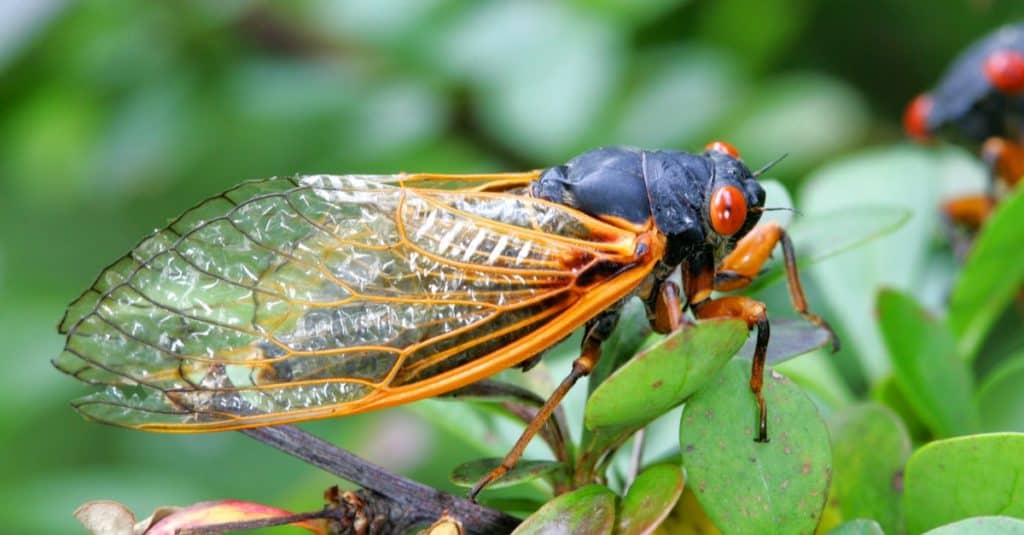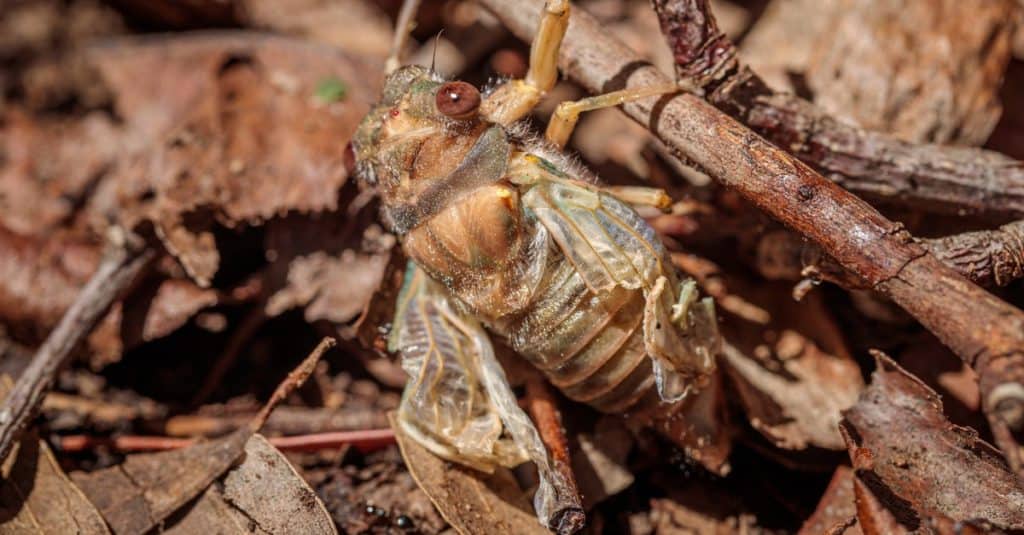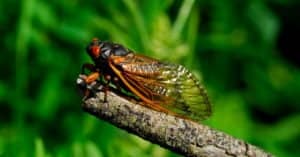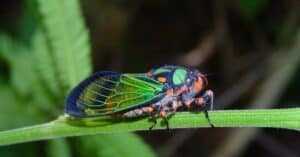In 2021, North America braced for the arrival of the Brood X or Brood 10 swarm of cicadas. This brood, which is actually a combination of three different cicada species, led to many curious questions about these large, buzzing bugs. Do they really swarm out of the ground? Why do they only arrive every 17 years? In this article, we’ll answer these questions and all the other questions you might have about these fascinating insects.
Although there are many cicada species, all cicadas fall into one of two larger groups: annual cicadas, which appear every year, and periodical cicadas, which emerge every 13 to 17 years. Brood X is a group of 17-year cicadas.
Interesting Facts About Brood X Cicadas
- Brood X’s pronunciation is “Brood 10” because every cicada brood has a Roman numeral.
- Brood X is also known as the Great Eastern Brood.
- Brood X is a group of 17-year cicadas and comprises three different species: Magicicada septendecim, Magicicada cassini and Magicicada septendecula.
- The noise cicadas make can reach 100 decibels. That’s like hearing a jackhammer or a chainsaw.
- Cicadas are considered a delicacy by many birds, small animals, and even humans.
What Is the Correct Pronunciation of Cicada?
The correct pronunciation is Sick-AY-Da.
What Do Cicadas Look Like?
A cicada is about three inches long with bright red eyes. A cicada is noted for its thick, squat body and translucent wings. They are famous for the unique buzzing sound they make.

Why Do Cicadas Only Come Out Every 17 Years? Scientists are trying to answer this by looking at cicadas like this one from brood II.
©Chris Alcock/Shutterstock.com
What Do Cicadas Sound Like?
Cicadas make a distinct noise that sounds like a constant, high-pitched buzzing and clicking. It’s actually the male cicadas who make the noise as a mating call. It can get very loud.
In some countries, annual cicadas mark the start of warm weather. In those countries, people welcome the sound of these insects as a harbinger of spring and summer. In regions that only see periodical cicadas, the noise can be grating.
Do Cicadas Have Predators?
They are considered a delicacy by many small animals. They are a favorite food of chickadees, sparrows, bluebirds, robins, and other birds. Snakes, turtles, sloths, lizards, meerkats, moles, anteaters, mice and rabbits will all feast on cicadas.
Humans eat them, too. Cicadas are a delicacy in China, where people eat the nymphs deep-fried in a special sauce. The 17-year Onandoga Brood is a ceremonial food of the Onandoga nation. People in Burma, Malaysia, Pakistan, and parts of North America all have cicada recipes.
What Is the Life Cycle of a Cicada?
The cicada life cycle includes eggs, nymphs and adults.
All cicadas begin their lives as eggs. Their mothers lay the eggs in the branches and leaves of trees. The eggs hatch about two months later.
When the hatchlings come out of their eggs, they fall off the trees and land on the ground. Once there, they burrow into the ground. Inside their burrows, they feed on sap from surrounding plant roots.
They stay underground until they develop fully as adults. The time this takes depends on many factors, including local weather conditions. Cicadas can’t emerge as adults until the weather is warm enough for mating.
Once conditions are right and they reach adulthood, the cicadas emerge from the ground and fly to the nearby trees.
Adults have a short life. They last about four weeks before dying or being eaten by other animals. During that time, they mate, lay eggs and start the whole cycle over again.
How Many Eggs Can a Cicada Lay?
Each female can lay about 600 eggs. When cicadas come out of the ground, they do so in huge numbers. One year, local researchers estimated there were over one million cicadas per acre in some eastern states.
Why Do So Many Cicadas Come Out at Once?
Researchers say cicadas use a technique called predator satiation to survive. Because they have so many predators, they make sure there are enough cicadas to feed all the predators. By emerging all at once, these periodical cicadas supply enough food for all the predators in the area. Once the predators are too stuffed to eat more, the remaining cicadas can reproduce without worrying about being eaten.
Why Do They Wait Underground for so Many Years?
Researchers still don’t fully understand why cicadas wait 13 or 17 years to emerge. There are several theories, however. The chief theory is that cicadas stay underground to avoid predators. Waiting for months or years means predators won’t rely on them as a food source. When they do come out, using predator satiation means they can sacrifice millions of brood members without harming the species’ chances of survival.
Another theory involves their diet. Cicada nymphs live on tree sap, which is mostly water. It’s poor in nutrients, and they need to drink a lot of it to grow to adulthood.
Where Can You Find Cicadas?
Annual cicadas are in every continent except Antarctica. Periodicals are unique to North America, where they concentrate in the central and eastern regions of the United States. A special cicada brood map will show you where to find each brood.
Where Can You See Brood X?
Cicada watchers have pinpointed places on the map where you’re more likely to see the 2021 brood. The most affected states include Georgia, Kentucky, New Jersey, New York, Maryland, Michigan, North Carolina, Pennsylvania, South Carolina, Tennessee, Virginia, and West Virginia.
Where Do Cicadas Live Until They Emerge?
They live in underground burrows, where they feed on root sap and other natural liquids. The nymphs go through five instar stages in their development underground. The difference in the 13- and 17-year life cycle exists because it takes a long time for the 17-year cicada’s second instar to mature. When they’re ready, they all come out at once.

Periodical Cicadas only come out every 17 years, like this cicada nymph struggling to climb in a garden.
©iStock.com/Jonathan Steinbeck
What Is a Cicada Brood?
A brood is a name given to a particular group of cicadas that emerge on a regular schedule. A brood can contain different cicada species if they are all on a similar schedule.
This is how researchers keep track of the various cicada groups. You can think of each brood as a large family. For instance, the 17-year Brood X is descended from the same brood that arrived in 2004, which was descended from the brood that arrived in 1987. Some broods include members that joined recently from other broods.
Some cicada broods have been appearing regularly for centuries. Researchers can map the areas where cicadas arrive to learn their patterns. Studying the patterns of one brood over time reveals a great deal of information about cicadas.
How Many Cicada Broods Are There?
There are 12 broods of 17-year cicadas and three broods of 13-year cicadas.
Enjoy This 17-Year Mystery
The periodical cicada remains an intriguing mystery. If you live in a state that’s expecting the 2021 brood, the best thing you can do is watch them and marvel at the wonders of nature.
Update on the 2021 Brood X
Here’s a fun look at what happened in May when the Brood X cicadas emerged with interesting film footage.
Cicada FAQs (Frequently Asked Questions)
Are Cicadas Insects?
Yes, they are insects. They are related to grasshoppers and leafhoppers.
What Is the Cicada’s Scientific Name?
The cicada’s scientific name is Cicadoidea.
- Phyllum: Athropoda
- Family: Cicadoidea
- Order: Hemiptera
- Suborder: Auchenorrhyncha
Cicadoidea is considered a “superfamily.” There are more than 3,000 species of cicada in the world.
What Do Cicadas Eat?
They eat the sap of plants.
Are Cicadas Dangerous?
They are harmless to humans. They are not venomous or aggressive.
Unlike some other insects that swarm, cicadas don’t damage crops or vegetation. Some gardeners worry that cicadas’ egg-laying technique can damage young or ornamental trees. Garden experts recommend covering these delicate plants with cheesecloth to keep the cicadas off them.
Are Cicadas Beneficial?
They provide a food source to many animals. After they die, their cast-off shells and bodies provide many nutrients to the soil.
Cicada Brood X News & Information
Brood X is currently (spring 2021) emerging on the east coast of the United States. More information and coverage can be found here!
- Cicadas in New York: What’s Happening Now?
- Cicadas in Pennsylvania: What’s Happening Now?
- Cicadas in Virginia: What’s Happening Now?
- Cicadas in Tennessee: What’s Happening Now?
- Cicadas in Washington, DC: What’s Happening Now?
- Cicadas in Maryland: What’s Happening Now?
- Here’s What 1.5 Million Cicadas Looks Like
- Will Cicadas Cause More Snakes? Copperheads?
- Can Dogs Eat Cicadas?
- Will Cicadas Eat My Tomato Plants?
- Cicada Brood X 2021: What is it and should you be concerned?
- Why Do Cicadas Only Come Out Every 17 Years?
- Cicadas vs Locusts: What’s The Difference?
How Do Cicadas Know When It is Time To Emerge?
Emerging from their underground burrows makes sense when you compare it to the annual cicada or even other animals that participate in hibernation, but how do these insects know when thirteen or more years have passed? What are the indicators for their internal alarm clocks?
It is believed that the cicadas have some sort of molecular clock within them that counts the cycles of their ecosystem as it change throughout the calendar year. This could be detected in the sap that makes up their diet and even detecting when leaves fall from trees to the ground. There could be numerous cues from their environment that help them count down the years!
The specific year and time to emerge is connected to the temperature of where the insects are. Their bodies sense the correct temperature to venture to the surface and see the world from a new view.
The photo featured at the top of this post is © Elliotte Rusty Harold/Shutterstock.com
Thank you for reading! Have some feedback for us? Contact the AZ Animals editorial team.





